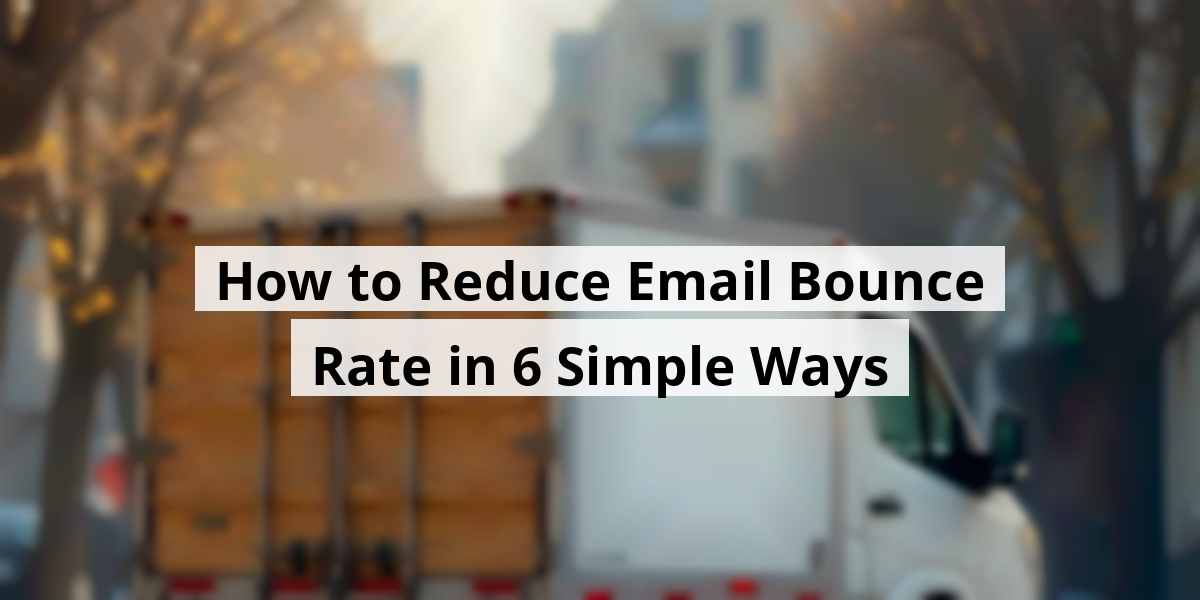 LIMITED SPOTS
All plans are 30% OFF for the first month! with the code WELCOME303
LIMITED SPOTS
All plans are 30% OFF for the first month! with the code WELCOME303

 LIMITED SPOTS
All plans are 30% OFF for the first month! with the code WELCOME303
LIMITED SPOTS
All plans are 30% OFF for the first month! with the code WELCOME303


Now we are going to talk about something that can really throw a wrench in our email plans: bounce rates. Let’s see what they are and why they matter.
Email bounce rate refers to how many of our emails don’t land in the inboxes we aimed for. Imagine sending an invitation to a party and getting it back with “Return to Sender” stamped on it. Bummer, right?
When an email bounces, it's like tossing a ball against a brick wall—*thud*—it just doesn’t go through. So we might think our carefully crafted messages are zipping around like confetti, but we might have a good number missing in action.
Now, let’s face it—there can be all sorts of things going wrong. Sometimes it’s on our end, like typos in email addresses or our inbox suddenly resembling a chaotic overflowing junk drawer. Other times, it’s the recipient’s fault. Maybe they’ve changed email addresses more times than they’ve changed their socks!
These bounces come in two flavors: hard and soft. Let's break those down!
To keep our email strategies sharp, we need to watch these rates closely. Keeping an eye on bounces is like checking the gas gauge before a road trip. Trust us, running out of fuel is never a fun adventure! Plus, it signals to us that we might need to clean up our email lists or revise our outreach strategies.
In the 2023 landscape of digital communication (where everyone’s inbox feels like Times Square on New Year's Eve), managing our bounce rates is more critical than ever. Recently, companies using automated email solutions reported a surge in deliverability by fine-tuning their lists and targeting genuine contacts. Clever moves, right?
Our aim should be to reduce bounce rates as much as possible—think of it like trying to achieve a hit rate in darts at the pub: we want to hit the bullseye, not the wall behind it. By finetuning our strategies based on the bounce types we’re seeing, we can boost deliverability and truly connect with our audience.
Next, we’re going to break down the differences between hard bounces and soft bounces in email marketing, and oh boy, it’s like trying to tell apart twins—one wears glasses, and the other doesn’t!


Hard bounces are like that friend who says they're coming to the party but then ghosts you on the day of. These emails get a big, fat “nope” from the server, meaning they’re permanently undeliverable.
There’s no point trying to resend them; it’s like trying to salvage a soggy piece of toast. Here’s a few reasons why you might hit a hard bounce:
Best bet? Remove those pesky addresses from your list. Trust us, it saves the headache later!
Soft bounces are a different beast altogether. They’re the “I’ll call you later” of email. These emails make it to the recipient’s mail server but don’t quite make it into the inbox.
There’s hope here! If you resend them a few days later, you might just have better luck. Here are a few reasons why soft bounces can happen:
If you experience a soft bounce, give it a shot again later. If it still bounces back after several attempts, time to leave that email behind.
To uncover what caused the bounce, it’s looking more like detective work. Using an email marketing platform is a good idea. Most platforms track the reasons for bounces, providing insights on how to address them.
For instance, using SendGrid can be super handy. Here’s how we tackle it:
Identifying the type of bounce is like finding the missing puzzle piece—it makes everything clearer!
Now that we have unraveled the mystery of hard and soft bounces, it’s time to discuss a healthy bounce rate for email campaigns, which is like maintaining a good diet: moderation is key!
Next, we are going to explore what an acceptable bounce rate looks like for our email campaigns. Spoiler: Keeping it low is the name of the game!

First things first, what’s a good bounce rate for emails? Most folks aim for less than 2%. It not only helps with email deliverability but also boosts our sender reputation, which is as crucial as picking the right flavor of ice cream on a hot day!
Now, there are tools available that can help us monitor this bouncy situation. One we love is Mailometeor. It’s like having a personal coach for our email campaigns. Just log in, navigate to the Campaigns section, and voilà — instant insights!
| Metric | Description |
|---|---|
| Emails sent | Total number of emails sent out successfully. |
| Opens | Percentage of recipients who opened the email. |
| Clicks | Percentage of recipients who clicked on links within the email. |
| Replied | This shows how many responded to our message. |
| Bounces | Percentage of emails that couldn’t be delivered, either due to hard or soft bounce issues. |
| Unsubscribes | Number of recipients who opted out of our list. |
Snazzy, right? As we track these metrics, it’ll be easier to see what’s working and what’s hitting the digital wall hard — like that one friend who always trips over their own feet at parties!
Now that we know what a decent bounce rate looks like, let's explore a few strategies to keep that number down in a jiffy!
By applying these tactics, we can keep that bounce rate in check and ensure our emails are received with open arms (and inboxes!).
Now we’re going to share some practical tips that can help fix that pesky email bounce rate!
Picture this: You’ve crafted the perfect email, and it’s ready to go, but it gets flagged as spam. Why? Often, it's because the sender isn’t authenticated. When emails bounce at rates above 2%, it’s time for a reality check on your authentication. To keep emails out of the spam abyss, getting the basics down is key. There are three essential protocols to set up:
A little off-topic, but I remember using a tool that manages these protocols — it was like having a personal assistant for my emails, and trust me, it was a game changer!
Ever receive a novel in your inbox? It's overwhelming! The truth is, email servers sometimes see long messages filled with links as suspicious. So, the shorter, the better. In our company, we’re all about quick and clear outreach emails. Imagine sending an email as concise as a text message — it’s refreshing! We strive for direct communication without overwhelming our audience. Nobody wants to read a tome when they can just get the gist in a few sentences!
Using words that scream “spam!” can make emails bounce like a rubber ball. We’ve all seen those subject lines that make you cringe — “100% free” or “Limited time offer.” You know the ones! Before hitting send, it’s wise to scan for such phrases. During one of our email campaigns, we utilized a spam checker, and it flagged several of our go-to phrases. Talk about an eye-opener! It’s helped us adapt our language and keep our emails where they belong — in inboxes.
Consistency is crucial. When emails are sent regularly, providers start to trust that you're not a fly-by-nighter. Think about it like showing up at your favorite café — if you’re consistent, the barista knows your order before you say a word! We set a timeline for our outreach emails, which boosts engagement and keeps bounces at bay. Just like with any good habit, consistency pays off big time!
Next up: Let’s play detective! Understanding email bounce patterns can uncover hidden issues. If you notice multiple addresses from a particular domain bouncing, it’s time to investigate. Example red flags include typos like “maill.ru” instead of “mail.ru” or missing “@” signs. So grab a spreadsheet and jot down those bounces — data is your best friend in this scenario!
Having a huge email list sounds fantastic, but if it's filled with inactive addresses, you’re just asking for trouble. It’s like hosting a party and inviting everyone, then finding out half of them RSVP’d long ago — most are no-shows! Email verification tools can help. Every time we prepare for a campaign, we ensure our outreach list is fresh, removing bounces before they become a problem. Trust us, it makes a world of difference in our overall delivery stats.
Follow these strategies, and you’ll find those bounce rates dwindling. Happy emailing!
Next, we are going to discuss some vital aspects of email bounces, their types, and effective strategies to keep those pesky rates as low as a limbo champion. If you’ve ever dabbled in the world of email campaigns, you likely know that a bounce can feel like a slap in the face—especially when you’ve crafted the perfect message. Let’s break it down.


Email bounces can be a bit like that one friend who doesn’t RSVP but shows up anyway; they’re surprising and can throw off your plans. There are mainly two types we should be aware of:
So, what does a healthy bounce rate look like? A bounce rate below 2% is often considered a good benchmark. If yours is creeping up, it might be time for a little spring cleaning. And no, I don’t mean your inbox, though we could all use a little digital decluttering there, too!
Now, let’s talk strategies because no one wants to be labeled the email equivalent of that random flyer that keeps bouncing back. Here’s how we can keep those bounce rates from rising like dough in a hot oven:
Even with these strategies, we can still run into issues. If link building feels like using a spaghetti strategy on a wall (throw it and hope it sticks), it might be time to reach out for guidance. Teams with experience can help strengthen those backlinks, making your outreach a breeze!
When it comes to email bounces, we can all agree that being proactive is the name of the game. Keep your bounce rates low, and your sender reputation high. With a good plan, we can ensure our email outreach doesn’t turn into a comedy of errors but rather a well-rehearsed performance!
Now we are going to talk about some common questions regarding email bounce rates. You know, those pesky moments when you hit "send" and a bunch of messages just... boomerang back to you. It’s almost like they have a mind of their own! Let’s take a look at these questions and sprinkle in some laughs, shall we?
Ah, the soft bounce! It's like your email had a first date, but the other party got cold feet. Try giving it another shot. If it fails again, consider taking a break. Maybe let it know you still care but aren’t desperate! If it bounces back third time, it’s time to say goodbye. Consider them uninvited to your email party.
Well, anything over 2% is like a neon flashing sign saying, “Houston, we have a problem!” If your bounce rate is creeping past that mark, it might be time to update that email list—like cleaning out your closet after a season change.
This can often be boiled down to two culprits: a lackluster subject line or possibly your email playing hide-and-seek in the spam folder. If your subject line isn’t pulling its weight, it’s likely lurking in the “promotions” tab or worse, the dreaded junk folder—like a kid getting sent to the corner during recess.

